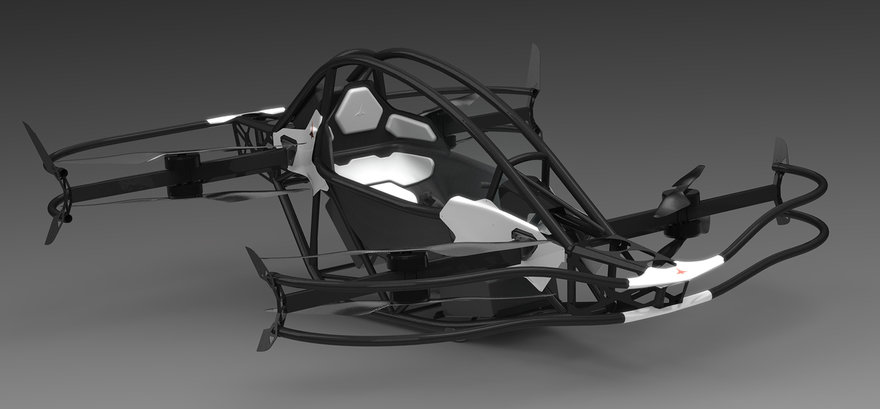
Jetson's Beautiful Form-Follows-Function Personal Flying Vehicle
Should be in the skies by 2022, runs 60 grand
It must have been fun to design cars in the early 20th century, before they had the form factors figured out. Initially they imitated their predecessors--horse-drawn carriages--until the 1920s and '30s, when designers and engineers allowed the function to shape the form.
 Horse-drawn carriage
Horse-drawn carriage
 1911 Ford Model T
1911 Ford Model T
 1930 Cadillac
1930 Cadillac
I feel like designers of personal flying vehicles have jumped directly to that 1920s step. Rather than aping what came before--helicopters and airplanes--the design team at Jetson, a flying vehicle startup, are going pure form follows function.
In 2017, when designing their prototype, they decided that an H-shape (in plan view) was most appropriate, with a rotor at each corner and the passenger seat in the center. For the sake of safety, each rotor was doubled. The redundancy ensures that "an engine failure would not be a catastrophic event," they explain.
After successful testing in Italy in 2018…
Enter a caption (optional)
…they then began refining the form. Their challenge was to find the most structurally-sound way of connecting the rotors with the seat, while balancing weight and basic safety concerns. I think what they've come up with is quite beautiful:













They completed the design last year during the pandemic--and orders for the $59,000 machine have already started coming in. They've got just 12 build slots for a fall 2022 release, and eight are already filled.

Regulations aside, what kinds of skills will it take to fly the thing? "By simple controls, we could move up, left, right, anywhere we wanted to go," the company writes of the prototype. "Perfectly stable, with the fly-by-wire system we had developed. If we took our hands off the joysticks, our machine simply stopped and hovered in the air.
"With our ultra-simple flight control system we were sure that everyone could be a pilot. This was the future of personal transport where you could effortlessly go, in the air, directly from start to destination without standing still in traffic ever again."


-
o1Favorite This
-
Q3Comment
K
{Welcome
Create a Core77 Account
Already have an account? Sign In
By creating a Core77 account you confirm that you accept the Terms of Use
K
Reset Password
Please enter your email and we will send an email to reset your password.


Comments
Cars still imitate the same wheel configuration as the horse-drawn carriages. And even electric cars, which have no need to do so and should be freer to be shaped differently, still have that configuration. The reason for this is the road infrastructure that sort of mandates this setup.
This signifies to me the problem of making personal flying vehicles.
Over the years we have seen several designs, of which this one is one of the prettier, that where never commercially successful. The importance and lack of a well designed infrastructure being the reason, in my opinion.
In itself it is a small vehicle but it requires a lot of three dimensional open space to safely operate it. Never have I seen that addressed as part of the design.
The web site quotes a maximum 15-minute flight duration. At the Part 103 mandated speed limit of 55 knots, that's a maximum range of 14 nautical or 16 statute miles. That's a pretty severe limitation. And the $60K buys you only a kit, not a completed aircraft. Also no mention of the generated noise level. It may look beautiful, but I certainly wouldn't want to listen to it.
I do like the form but how exposed those props are seems like a liability.